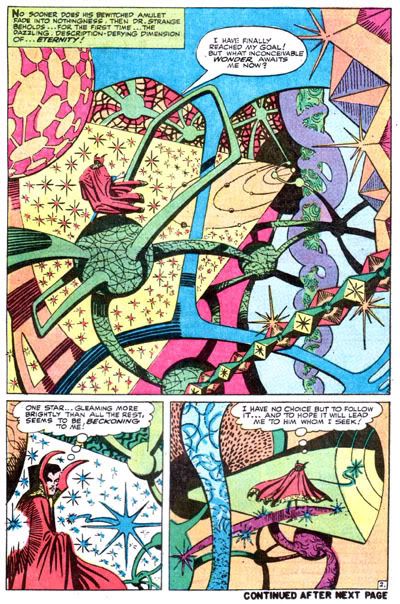
Art by Steve Ditko
Doctor Strange was created by artist Steve Ditko and writer/editor Stan Lee, the same team that created the Amazing Spider-Man. Strange first appeared in "Strange Tales" #110, cover dated July 1963. He appeared twice in "Strange Tales", was absent two issues, and then returned as a regular feature of the title with issue #114, dated November 1963. Doctor Strange's introduction came mere months before the initial broadcast of "Doctor Who".
"Strange Tales" was a two feature title shared between Doctor Strange and the Human Torch . In 1965 the Human Torch feature was replaced by adventures of the left-eye missing super-spy Nick Fury, Marvel's answer to James Bond and "The Man From U.N.C.L.E.".
The association between Strange and John Dee is not missed by Neil Gaiman who cast Doctor Strange in the role of court magician and adviser to Queen Elizabeth I in the 2003 miniseries "Marvel 1602".

Art by Scott McKowen
Doctor Strange is one of the rare comic book super heroes to have an established date of birth, November 18th, 1930, making him a Scorpio. There are few other super heroes whose daily horoscope one could peruse. Strange was born in Philadelphia, PA, a characteristic I believe was chosen as a reference to America's most famous "wizard" Benjamin Franklin.
Before being trained in magic Doctor Strange was an accomplished neurosurgeon, highly gifted but arrogant and self-interested. An auto accident caused permanent nerve damage that limited the fine-motor control of his hands. This led him to seek out a legendary Tibetan healer known as the Ancient One. The Ancient One sensed great potential in Strange and offered to take him on as an apprentice, an offer Strange dismissed. As a scientist Strange could not accept the existence of literal magic. But while at the Himalayan abode Strange witnessed a mystical attack on the Ancient One by the sorcerer's apprentice Baron Mordo.
Mordo prevented Strange from warning the Ancient One by mystically binding him. Aware now of the reality of magic, Strange had a spontaneous change of heart and decided he must learn to wield magic in order to serve as a counter to the evil Baron Mordo. The Ancient One, who as a far greater magician was never in any danger, released Strange from Mordo's binding and revealed that he let events proceed in order for Strange to find his true purpose. Strange studied with the Ancient One for seven years before returning to New York City as a protector of humanity from all things supernaturally malicious. Amongst Doctor Strange's near infinite array of magical abilities is his frequent use of astral projection and acts of clairvoyance assisted by his illuminating Eye of Agamotto which when used in this manner positions itself over Doctor Strange's third eye.
The process of enlightenment is readily apparent in Doctor Strange's origin, complete with Himalayan quest, and finding a higher purpose while "bound". Doctor Strange's base of operation is termed the The Sanctum Sanctorum (Latin for the "Holiest of Holies"). Like the TARDIS, the Sanctum Sanctorum is dimensionally transcendent, with an interior of much greater size than the exterior. A few years into his career Doctor Strange is forced to sacrifice the Ancient One in order to save the world from the entity Shuma-Gorath, an extrapolation of a Robert E. Howard creation with Lovecraftian overtones, which sought entry to the Earthly plane via the Ancient One's mind. Strange inherited the mantle of Sorcerer Supreme, and the Ancient One transcended into a purely spiritual entity who continues on occasion to advise Strange in ghostly form.
Other major opponents of Doctor Strange include the supernatural entity Nightmare, Mephisto, Marvel's Satan, the Marvel Comics version of Dracula and the Dreaded Dormammu, ruler of the Dark Dimension. In "Strange Tales" #138, November 1965 Doctor Strange first met Eternity, the sum of all existence incarnate.
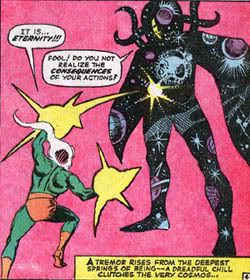
Dormammu and Eternity, art by Steve Ditko
In issue #157-158, the summer of 1967, Strange communed with an even greater conceptual entity, the Living Tribunal, a tripartite god in singular form representing three essential principles described as Necessity, Equity and Vengeance.

Art by Steve Ditko
The above image was reproduced a year later on Pink Floyd's album "A Saucerful of Secrets", the last to feature Syd Barrett.
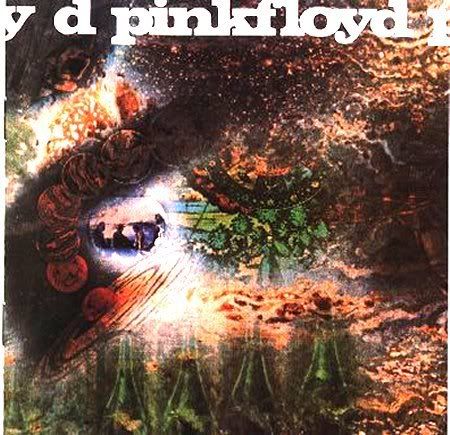
The Tribunal can be seen in the upper left corner, Strange, in Orion posture, is on the far right. Doctor Strange is also referenced in Pink Floyd's "Cymbaline", as well as in the T.Rex song "Mambo Sun", and "Superbird" by Country Joe and the Fish. Another album cover featuring Doctor Strange is Al Stewart's "Past Present and Future" from 1973.
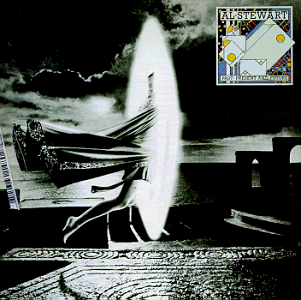
Doctor Strange is also one of many comic book super heroes referenced in Tom Wolfe's "The Electric Kool-Aid Acid Test". Wolfe made an appearance in "Doctor Strange" #180, May 1969, as an acquaintance of Doctor Strange. In recent days Doctor Strange is depicted as one of the members of Marvel's Illuminati, a ultra-secret organization revealed to have been manipulating certain key-events of Marvel history. Other members include the Hermetic Submariner, and the mentor of the X-Men Professor Charles Xavier. The concept of a super team whose existence is unknown to the world at large, including most of the super hero community, was first explored in association with Doctor Strange in 1969 when he founded the "non-team" called The Defenders. The other initial members were again the Submariner, the Apollonian/Dionysian Incredible Hulk, and on occasion the Hermetic Silver Surfer.
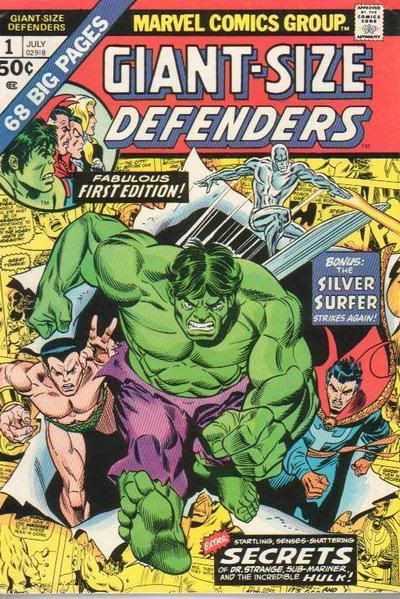
Art by Gil Kane and John Romita (Surfer figure)
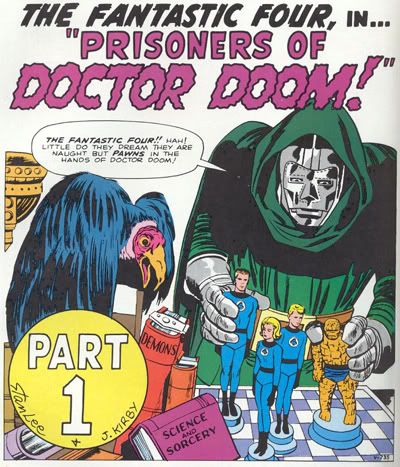
Art by Jack Kirby
Doctor Victor von Doom is unquestionably the greatest Marvel super-villain and arguably the greatest of all comic book super villains. He first appeared in "Fantastic Four" #5, July 1962, designed to be the arch nemesis of Marvel's first super team. In the issue Doom took the Invisible Girl hostage and forced Mr. Fantastic, the Thing and the Human Torch to utilize Doom's Time-Platform to travel hundreds of years into the past and steal the pirate Blackbeard's treasure. The Time-Platform is considered the first operational Time Machine of the Marvel Universe.
Doctor Doom (note the phonetic similarity to Doctor Du) was born in the fictional nation of Latveria and is of Roma/Gypsy decent. His mother was a witch who sold her soul to Mephisto, and was murdered by soldiers of Latveria's baron while Victor was still an infant. A few years later, when his father, a healer, was unable to prevent the death of the baron's wife, Victor and his father were forced to flee to a local mountain range where Victor's father died of exposure. Young Doom vowed at that time to make all of humanity pay for the loss of his parents. Discovering his mother's collection of mystic artifacts, young Doom began his study of both the occult and modern science.
Doom possesses one of the greatest minds of the Marvel Universe, rivaled only by Reed "Mr.Fantastic" Richards of the Fantastic Four. The enmity between the two first arose when both were students at Empire State University. Doom was conducting dangerous experiments and constructed a device to allow him to look into other dimensional planes in order to locate his mother's soul. Richards noted an error in Doom's "trans-dimensional projection device", but Doom felt Richards to be his inferior and ignored his warning. Doom's device did work but the machine exploded, scarring Doom's face, a condition his vanity could not abide. He blamed Richards for the accident and vowed revenge. Expelled from ESU, Doom traveled the world looking for any means of curing his scars. He eventually made his way to an enclave of Tibetan monks with whom he stayed for several years. Mastering their magic, Doom soon came to control the monastery. The monks assist Doom in the forging of his emblematic suit of armor and mask (note the similarity to the origin of Dr. Strange). Doom further adapted the mystic armor by adding numerous technological devices and weapons including jets for flying and an impenetrable force field. During his villainous career Doom builds numerous inventions including robots with full artificial intelligence.
After Doom donned his armor he returned to Latveria, overthrew the government and crowned himself king. Doom is an absolute monarch but his rule brought unprecedented prosperity to his nation. Wikipedia describes Doom's manner of rule as enlightened absolutism. Doom's sovereignty further granted him a near unique attribute as a super-villain, diplomatic immunity.
Amongst Doom's magical powers is an ability to open portals to other dimensional planes such as Mephisto's Hell-like realm and the Australian Aboriginal Dream Time. Early in the character's career Doctor Doom learned from an alien race called the Ovoids to psionically transfer his consciousness with another individual by making eye contact.
Doctor Doom teams up frequently with the Submariner, the first time in Doom's second appearance, "Fantastic Four" #6, August 1962.

Art by Jack Kirby
Another milestone in Doctor Doom's career occurred in "Fantastic Four" #s 56-60, December 1966 to March 1967. Doom managed to capture the Silver Surfer by trickery and stole the Surfer's Cosmic Power and Surfboard.
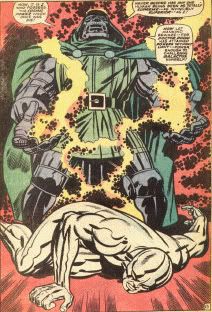
Art by Jack Kirby
Doctor Doom and Doctor Strange have also worked together as allies, most notably in the Marvel Graphic Novel "Doctor Strange and Doctor Doom: Triumph and Torment", in which the two enter Mephisto's realm and free the soul of Doom's mother.
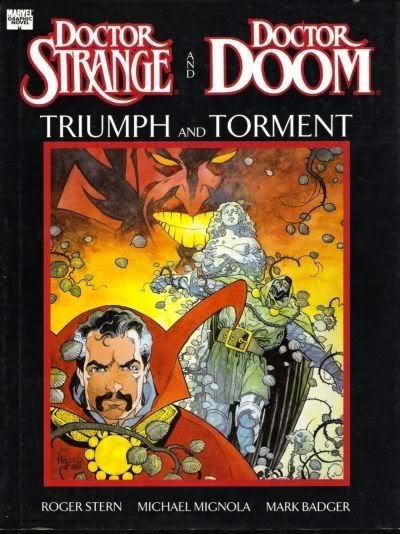
Art by Mike Mignola
While much of the mythology of "Star Wars" was clearly drawn from Jack Kirby's Fourth World, the character of Darth Vader was largely inspired by Kirby's Doctor Doom.
1963 it seems was a banner year for Doctors in high fantasy fiction. The July 1963 "Amazing Spider-Man" #3 introduced the world to Doctor Octopus, a character once again created by the team of Lee and Ditko.
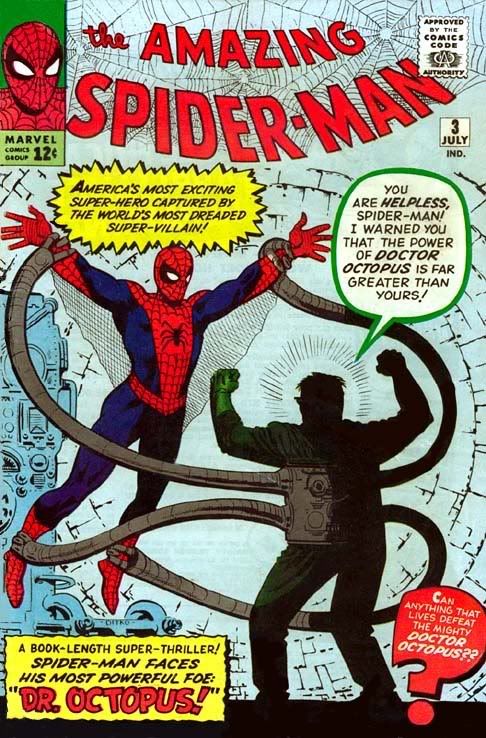
Art by Steve Ditko
Lacking the apparent occult overtones of Doctors Strange and Doom, Doctor Octopus allows us the opportunity to observe the super hero comic book use of nuclear science and radiation as a metaphor for transformation/illumination. Doctor Octopus is a member of that wonderful species of super villain, the Mad Scientist (and while Strange is clearly magical and Octopus scientific, Doom is the balanced synthesis of the two, a proper alchemist). All Mad Scientists are branches off the Tree of the Promethean Doctor Frankenstein.
Otto Octavius was born into a working class family in Schenectady, New York (the home of General Electric) and was the victim of lifelong physical abuse from his father. This led Octavius to pursue a study of the physical sciences so that he could escape the life of a common laborer. A scientific genius (with socialization difficulties that today might label Octavius a victim of Asperger Syndrome), he comes to be one of the world's most gifted and respected nuclear physicists and inventors. His greatest invention is his tentacled harness, designed as a device to conduct atomic research with radioactive isotopes. A radiation leak caused an explosion that fused the tentacles to Octavius' body. The accident also mutated Octavius' mind, allowing him complete motor-control of his accidental prosthetics as if they were his natural limbs and making him a sociopathic criminal. He was reborn as Doctor Octopus. Later in his career, after the tentacles were surgically removed, Octopus displayed his mental control to be fully psychokinetic, allowing him operation of the tentacles even at a distance.
Doctor Octopus is perhaps Spider-Man's greatest villain (a status rivaled only by the original Green Goblin). With his multi-functional tentacles strong enough to bend steel Doctor Octopus is a fair match for the web-slinger. In their first encounter Spider-Man was so badly beaten he considered giving up his heroic career, but was inspired to carry on by the Human Torch (of course).
There is interest to be had in the symbolic connotations of the Octopus. We can of course easily see the significant number eight in the character's name and his design. The fact that four of his limbs are normal and four specialized or enhanced, adds a clear duality to this allegorical Octagram. The symbolic significance of this does not seem to have been missed by illustrator Kaare Andrews, the artist of 2004's "Spider-Man/Doctor Octopus: Year One".

Art by Kaare Andrews

Leonardo DiVinci's "Vitruvian Man", c. 1492
The symmetrical form of the Octopus, it's aquatic nature, it's large round eyes, and other factors (such as the tentacles propensity to take spiral form) make it a deeply significant symbol since prehistoric times. It was the model for mythological beasts like Scylla and the Kraken. Its physical appearance may also relate to Medusa and other Gorgons. Hans Biedermann informs us that the cuttlefish is occasionally associated with the zodiac sign of Cancer. Juan Eduardo Cirlot intriguingly states, "(the Octopus) is related to the spider's web and the spiral, both being symbolic of the mystic Centre and of the unfolding of creation". Add to this the symbolic envisioning of a world-controlling collection of secret cabals as an "Octopus" and the dark, godlike cephalopodic forms of the Lovecraft mythos, and you have a very potent metaphorical chowder indeed. As formidable, or even more so, then the Spider.
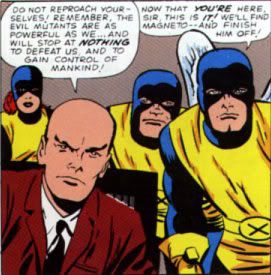
Art by Jack Kirby
The focus of this investigation is on high fantasy characters identified by name as Doctors, which I contend is a detail that designates them as symbolic instructors of the Invisible College. The only possible term that could be even more indicative of this is that of Professor. This is a topic I discussed earlier in Mercury Retrograde. In that article I make mention of the Lee/Kirby character Professor X and his School For Gifted Youngsters, a clandestine education center where Professor X houses and trains the X-Men and The New Mutants.
Professor Charles Xavier was introduced in "X-Men" #1, again in 1963. Like his students he is a mutant, specifically a telepath of great power, termed the world's most powerful mutant mind. These mental gifts are contrasted with Xavier's status as a paraplegic, a condition Xavier suffered when his legs were crushed by a block of stone early in his career while fighting an alien entity calling itself Lucifer (prior to his first appearance). This life-altering event occurred in Tibet.
Xavier's mutant ability is such that he can read and manipulate minds in a radius of hundreds of miles. He can also fully alter perceptions, erase memories, induce mental, emotional or physiological experiences, fire "mental bolts" that debilitate their targets, and astral project like Doctor Strange.
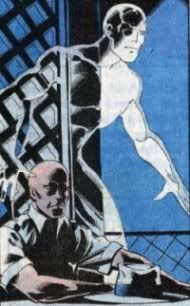
Art by John Byrne
Xavier is the son of a wealthy nuclear physicist, ostensibly the cause of Xavier's mutant nature. A child prodigy, Xavier graduated with honors from Harvard at the age of sixteen and went on to earn Ph.D.s in genetics, biophysics and psychology. Besides his clandestine Professor status, he also for a time served as an Adjunct Professor at Columbia University. Xavier also displays great skill as an inventor, designing the elaborate X-Men training center "the Danger Room" and the mutant detecting device Cerebro.
During his world travels, but prior to his encounter with Lucifer, Xavier engaged in a psychic duel with Amahl Farouk, the Shadow King, in Cairo, Egypt. This encounter caused Xavier to dedicate his life to the protection of humanity from evil mutants, and to protect mutants from the prejudices of humankind. Xavier believed humans and mutants could learn to coexist peacefully, a philosophy that came to be termed "Xavier's Dream" by his students, and in contrast to the terrorist tactics of his former friend Magneto. It is not uncommon for parallels to be drawn between Professor X and Reverend Martin Luther King, Jr. both inside and outside the comic book page.
The purely mental abilities of Professor X are contrasted by the purely physical nature of his step-brother Cain Marko, the Juggernaut. Marko is not a mutant, but rather was mystically transformed by the Crimson Gem of Cyttorak. The dimension of Cyttorak is the source of one of Doctor Strange's most frequent spells, the Crimson Bands of Cyttorak, which are capable of binding almost any entity. As mentioned earlier, Xavier and Strange are both members of Marvel's Illuminati. Xavier has had more then one love interest, most notably Lilandra, Empress of the multi-galaxy spanning Empire of the Shi'ar, a race evolved from birds.
Like nearly all comic book characters with any amount of history Professor X has seemingly been killed and returned many times. Perhaps the most prominent example of this came in "X-Men" #42, March 1968, when the Professor was mortally wounded while battling Grotesk, the Prince of a subterranean civilization.
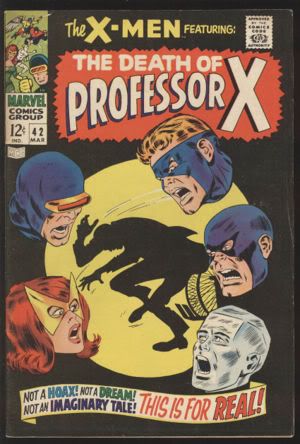
Art by Don Heck
He remained dead until issue #65, February 1970, where it was revealed that the Professor X who had died was really the shape-changing mutant Changeling. Xavier employed Changeling to stand-in for him while he sequestered himself in preparation for repelling an alien invasion he had psionically detected. Despite his altruistic principles Professor Xavier demonstrates frequent instances where he behaves in a highly secretive, and at times manipulative manner. His mutant advocacy not withstanding, Professor Xavier's own status as a mutant and as the leader of the X-Men was not made public until recently in X-Men continuity.
According to Wikipedia the name Charles Francis Xavier may have been derived from St. Francis Xavier (cofounder of the Jesuit Order), the physiologist Marie Francois Xavier Bichat , or the character Charles Xavier Vseslav/Charles Kinbote from the 1962 Vladimir Nabokov novel "Pale Fire". The latter perhaps carries the most credence as the middle name "Francis" was not added to the character until the mid-90s (a fact I was unaware of until researching this article). However, the addition very well could have been made to attach the symbolism of St. Francis Xavier to Professor X, as well as that of the major esoteric figure Francis Bacon.
That's more then enough for now I'm sure. There are of course more obscure Marvel Doctors that I hope to make mention of at a later time. Part III of this series, however, deals with the major Doctor figures of Marvel's Distinguished Competition.
No comments:
Post a Comment